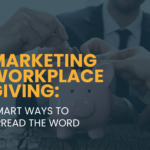Expert Workplace Giving Strategies for Fundraising Teams
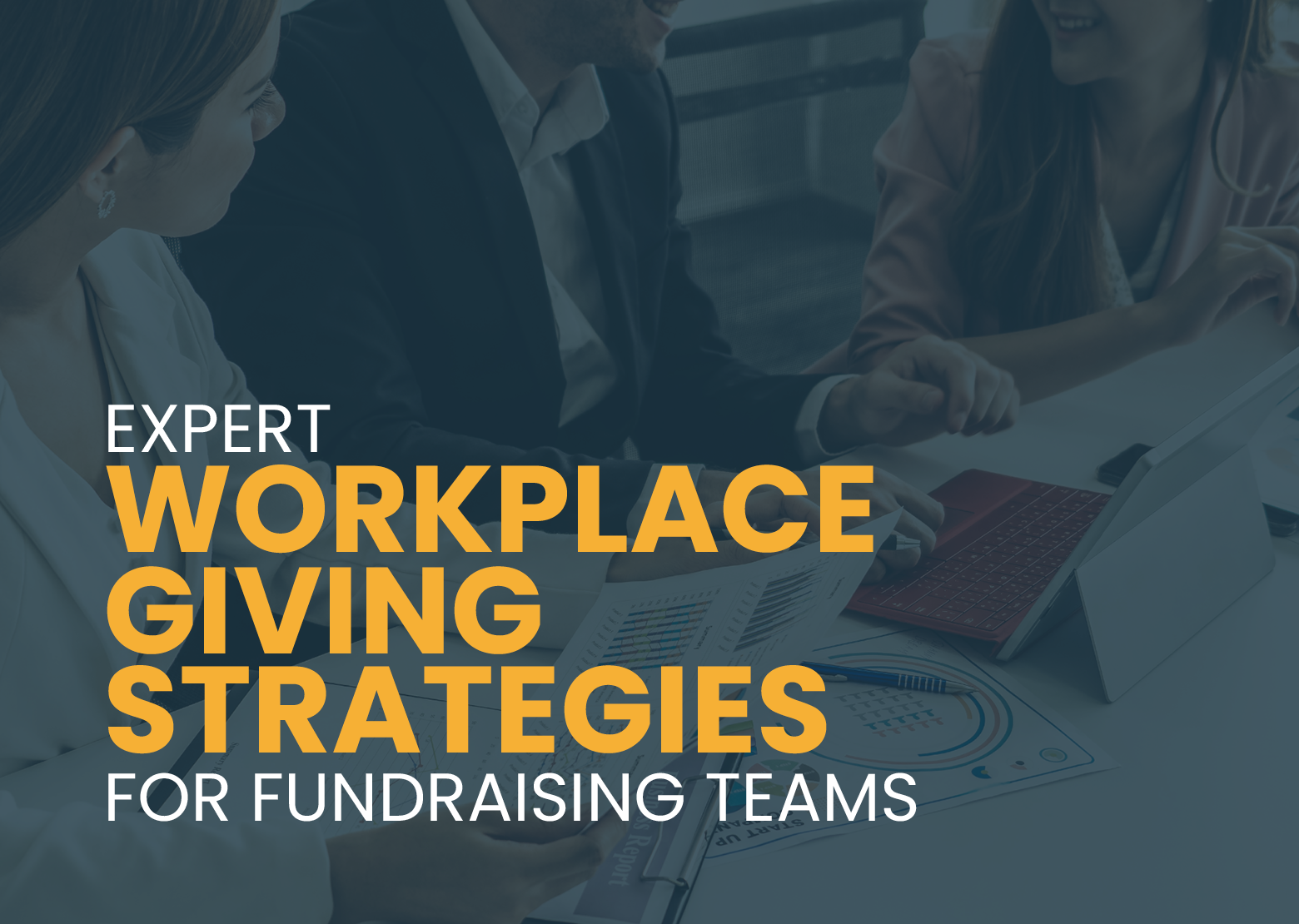
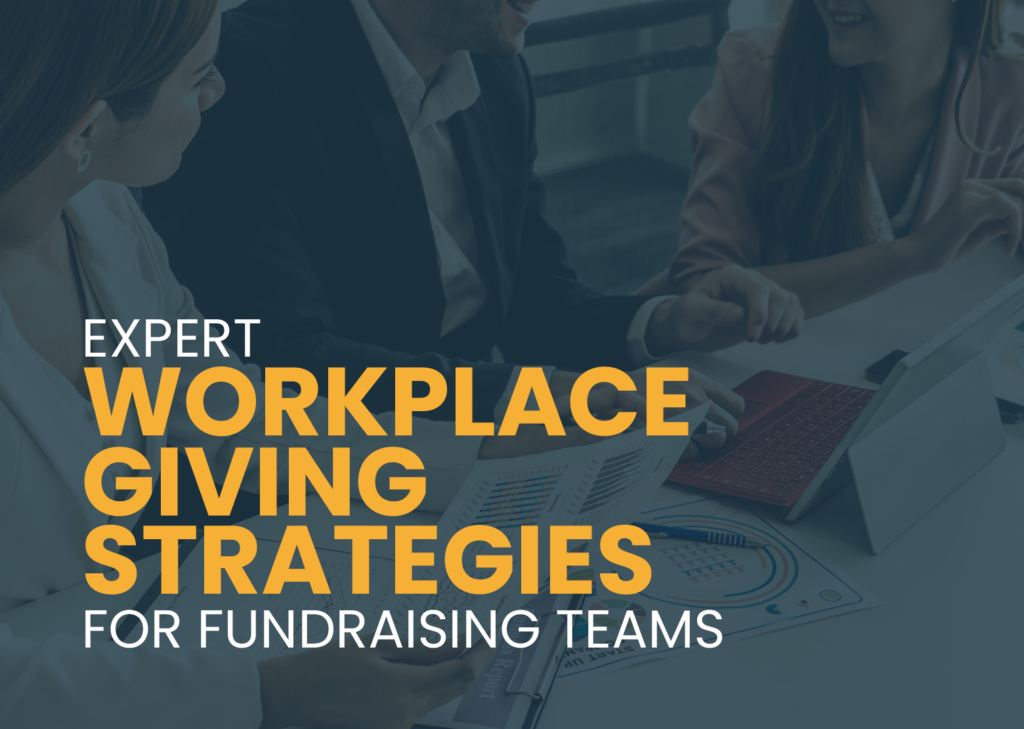
Workplace giving has become a powerful tool for nonprofits and other fundraising organizations aiming to boost their efforts and engage more support.
From corporate matching gifts to employee volunteer programs and beyond, these initiatives not only provide significant financial benefits for nonprofits but also encourage a culture of generosity throughout.
In this post, we’ll explore expert workplace giving strategies that fundraisers can use to bring their efforts to the next level, ensuring they capture every possible opportunity for growth.
These include:
- Training your fundraising staff on all things workplace giving.
- Sharing workplace giving information on your website.
- Taking an omnichannel approach to marketing workplace giving.
- Investing in a dedicated workplace giving database.
- Engaging supporters in multiple workplace giving opportunities.
- Exploring one-off workplace giving partnerships.
- Providing donors with tools to lobby for new workplace giving programs.
- Helping organize corporate volunteer days.
For fundraising teams, strategically leveraging workplace giving programs can unlock new revenue streams, strengthen donor relationships, and maximize the impact of their campaigns.
Ready to find out how your organization can do so effectively? Let’s dive in with our first recommendation.
Train your fundraising staff on all things workplace giving.
To maximize workplace giving opportunities, organizations should ensure that their fundraising staff are well-versed in all aspects of these programs. While there are a ton of ways to participate in workplace giving, some of the most popular examples (that you’ll definitely want your training to cover) include…
- Matching gifts: Companies match donations made by their employees to eligible nonprofit organizations, doubling or tripling the original gift.
- Volunteer grants: Companies provide monetary donations to nonprofits based on the number of hours an employee volunteers.
- Volunteer time off: Companies supply employees with paid time off from work to volunteer with nonprofit organizations.
- Payroll giving: Companies empower employees to donate to nonprofits directly from their paychecks, often with the option for pre-tax contributions.
For the best results, staff should understand the potential financial impact of these programs, know how to identify prospects, and be skilled in communicating the benefits to donors and corporate partners alike.
Regular workshops and refresher courses can keep your team updated on the latest trends, tools, and regulations surrounding workplace giving. Moreover, training should emphasize personalized donor engagement strategies so staff can effectively communicate the value of workplace giving and encourage donor participation.
💡 Check out Double the Donation’s Matching Gift Academy (free for current clients) to learn all about matching gift best practices and more.
Share workplace giving information on your website.
Your nonprofit’s website is one of your most invaluable assets for connecting with interested supporters—and providing the details they need to get involved. When it comes to driving workplace giving, equipping your site with the right information can go a long way. For this reason, we recommend establishing a dedicated web page to act as a hub for everything related to workplace giving. This should include:
- Popular types of workplace giving programs to consider.
- An overview of workplace giving and its advantages for donors, their companies, and the nonprofits they support.
- How donors can identify and get involved with workplace giving programs offered by their employers.
- A workplace giving database search tool (more on that later!).
- Organizational information, including contact details (mailing address, EIN, etc.) that may be required for workplace giving submissions.
- Links to separate pages on Matching Gifts, Corporate Volunteerism, and more.
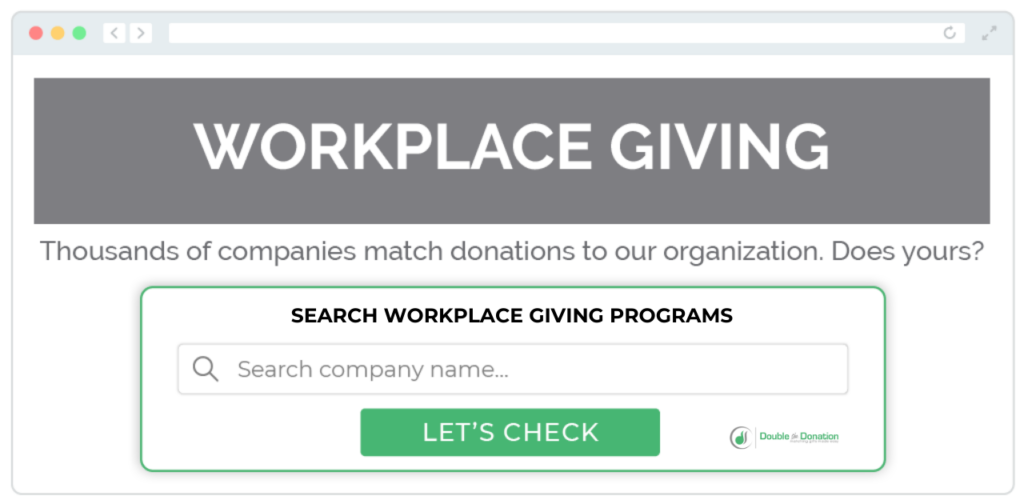 This online presence not only informs potential donors about workplace giving opportunities but also positions the organization as an expert in the programs, building trust and encouraging participation.
This online presence not only informs potential donors about workplace giving opportunities but also positions the organization as an expert in the programs, building trust and encouraging participation.
Take an omnichannel approach to marketing workplace giving.
There’s a significant knowledge gap facing workplace giving programs, and it’s the reason why tons of organizations are letting available support slip through the cracks. According to our guide to Marketing Workplace Giving,
“This lack of realized potential is largely based on insufficient awareness regarding the programs. For example, while 26 million individuals work for companies that match gifts, an estimated 78% have never been made aware of the opportunity. Meanwhile, 59% of survey respondents haven’t heard of payroll giving programs, either.”
To reach the widest audience possible, organizations should use a multichannel marketing strategy to promote workplace giving. In addition to your website (which we already covered), you’ll want to utilize a combination of the following promotional avenues in order to educate supporters about workplace giving options:
- Email and newsletters
- Social media posts
- Text messages
- Direct mail
- In-person events
- And more!
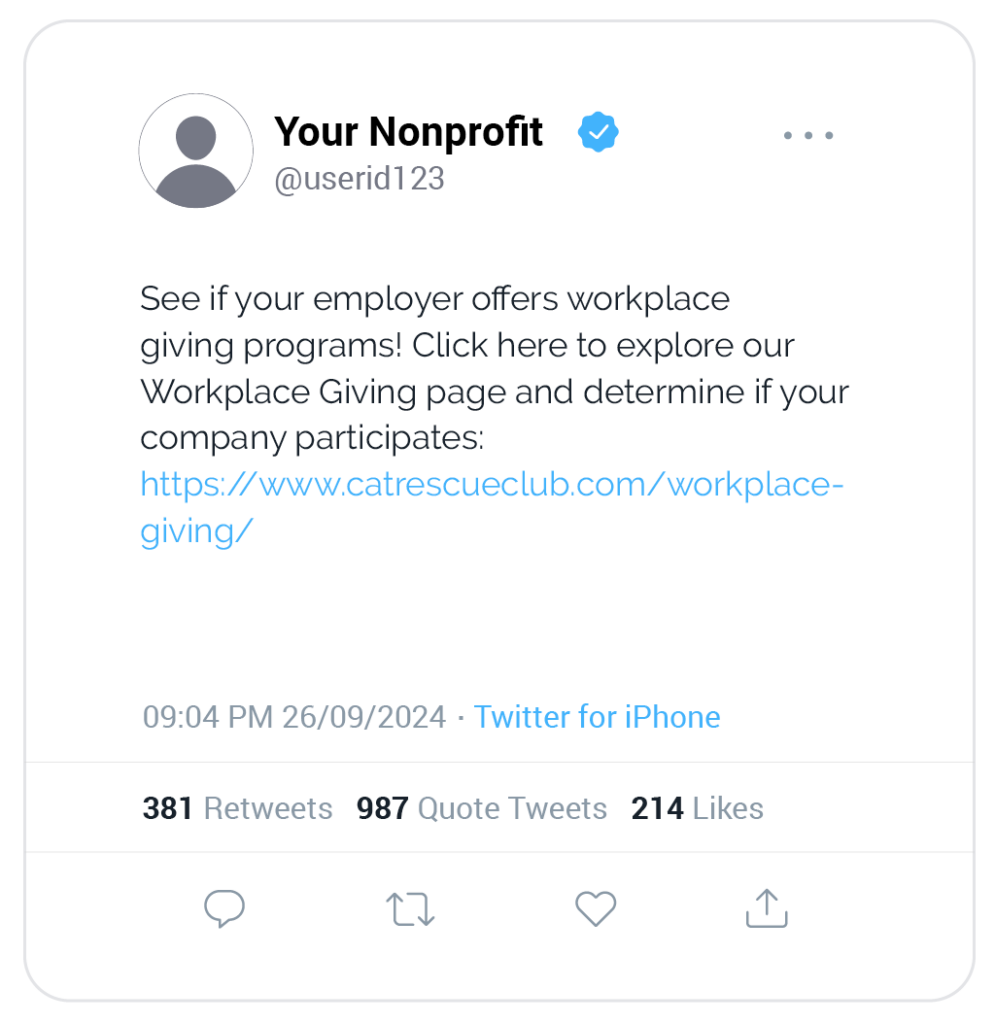 Consistent messaging across all channels ensures donors are aware of the available programs and understand the impact their contributions can make. Personalizing outreach based on donor behavior, such as acknowledging previous workplace giving participation, can also boost engagement.
Consistent messaging across all channels ensures donors are aware of the available programs and understand the impact their contributions can make. Personalizing outreach based on donor behavior, such as acknowledging previous workplace giving participation, can also boost engagement.
Invest in a dedicated workplace giving database.
Thousands of companies offer workplace giving programs, but there’s no simple way to keep track of all the initiatives on your own. Lucky for you, Double the Donation maintains an extensive database of program information that makes searching for and uncovering eligible opportunities quick and easy.
Here’s how the solution works:
- An individual enters their employer’s name in a database search tool (on your website, donation forms, etc.).
- The tool screens the information provided against its comprehensive database to locate information about the company’s existing workplace giving programs.
- If the selected company offers a matching gift, volunteer grant, or VTO program, the database tool provides information about how the individual can get involved—including direct links to online submission forms.
 A comprehensive database allows for easy monitoring of matching gifts, volunteer incentives, and more, helping fundraising teams stay organized and follow up with donors effectively. It also makes it possible to segment individuals based on their eligibility for workplace giving programs, enabling more personalized communication.
A comprehensive database allows for easy monitoring of matching gifts, volunteer incentives, and more, helping fundraising teams stay organized and follow up with donors effectively. It also makes it possible to segment individuals based on their eligibility for workplace giving programs, enabling more personalized communication.
Additionally, a robust database can provide insights into the most influential corporate partnerships and help identify trends in workplace giving, guiding future strategy. With centralized and accurate data, organizations can ensure they capture all available workplace giving revenue while making informed decisions about how to grow these programs further.
Engage supporters in multiple workplace giving opportunities.
There’s no one way for an individual to partake in workplace giving, especially when the companies that offer the programs generally tend to establish more than one way to give. That said, inviting your supporters to get involved in numerous workplace giving programs can have a significant impact on your overall engagement.
A few of our favorite ways to do so include:
Getting volunteers to contribute financially by promoting matching gifts. Don’t overlook your volunteers when it comes to soliciting financial contributions. This is especially true for your match-eligible volunteers! After all, research shows that 84% of donors are more likely to give if a match is offered.
Encouraging donors to volunteer by highlighting volunteer grants or volunteer time off. Alternatively, your donors can be some of your greatest resources, and the availability of a corporate volunteer incentive can go a long way in driving tangible, hands-on support.
Driving payroll giving donors to get their gifts matched. In many cases, donations made through payroll deduction programs will also qualify for matching gifts. Ask these workplace giving donors to go a step further for your cause by requesting a matching gift!
Explore one-off workplace giving partnerships.
While ongoing workplace giving programs offer long-term advantages for the businesses and nonprofit organizations that benefit, not all companies offer these initiatives yet. Fortunately, one-off workplace giving partnerships can function as an excellent way to engage businesses in a short-term manner.
This can involve:
- One-off matching gift programs, where the company matches gifts exclusively to a single organization, usually for a limited time.
- Volunteer events organized between a company and a nonprofit its staff would like to support. This can occur during the work day (using Volunteer Time Off) or after hours!
- Volunteer grants offered to an organization its team members spend their time and energy supporting.
While generally short-term in nature, one-off partnerships like these can provide a significant boost to fundraising efforts and lay the foundation for future collaborations.
By experimenting with different partnership formats and finding what resonates with companies, nonprofits can unlock additional workplace giving opportunities and foster lasting corporate relationships.
Provide donors with tools to lobby for new workplace giving programs.
Passionate donors have the potential to get new workplace giving programs started. All your nonprofit needs to do is inspire them by fulfilling your mission and emphasizing the important role CSR initiatives play in your work. Then, provide them with the resources they need to advocate for a new program, such as:
- Educational materials about the basic process. For interested donors, provide materials that explain what a workplace giving program is and what steps a company would need to take to implement one. For example, let’s say an employee wants to advocate for a matching gift program. To help them out, provide materials that outline the requirements about which gifts should be matched that companies need to consider.
- Benefits breakdown. With any proposal, you need to explain why implementing your suggestion benefits whomever you’re persuading. Provide statistics you can share with companies, such as how workplace giving can boost employee retention or what percentage of consumers want to buy from companies that conduct CSR initiatives.
- Competitors analysis. Encourage donors to research similar companies to their employers that have workplace giving programs. Your nonprofit’s matching gift software can help you here, as you can easily search for other businesses and find comparisons. Competitor analysis can be persuasive as it shows companies that businesses of all sizes, from worldwide operations to mom-and-pop businesses, offer workplace giving programs.
Here’s an example letter template you might share with supporters to advocate for a workplace giving program:
Hi [manager or HR representative name],
I am writing to request the addition of a workplace giving program at [company name].
Thousands of companies already offer workplace giving programs to support causes that matter and demonstrate their commitment to their employees’ values. In particular, matching gift programs, wherein [company name] agrees to match employees’ donations can be an effective and straightforward way to begin making a difference.
Companies that implement workplace giving programs can also expect business-related benefits. These programs result in improved employee engagement and retention, opportunities to attract competitive candidates, a positive brand image, and even increased sales.
To better understand the impact that workplace giving can have on [company name], I recommend checking out matching programs from [comparable business].
=If you would like to conduct more research before making a decision, Double the Donation has provided a detailed guide that walks corporate leaders through the process. You can access this resourcehereand usetheir free templateto kickstart the policy creation process.
Thank you for your consideration,
[Your name] [Job position] [Contact information]
Additionally, more tech-savvy donors can also discuss the potential benefits of workplace giving software. For example, you may educate donors on how they can use their employers’ matching gift auto-submission tools to make the matching gift process faster and easier. Then, donors can recommend their employers consider technology like auto-submission functionality when selecting a CSR platform.
Help organize corporate volunteer days.
Outside of matching gift programs, nonprofits can coordinate other types of CSR activities, like corporate volunteerism. In particular, corporate volunteer days can help your nonprofit make progress on initiatives by recruiting more volunteers while also strengthening your relationship with the business they work for. After all, employees are five times more engaged when their employer offers a volunteer program, making volunteerism an important part of any company’s philanthropy.
Essentially corporate volunteer days work like this:
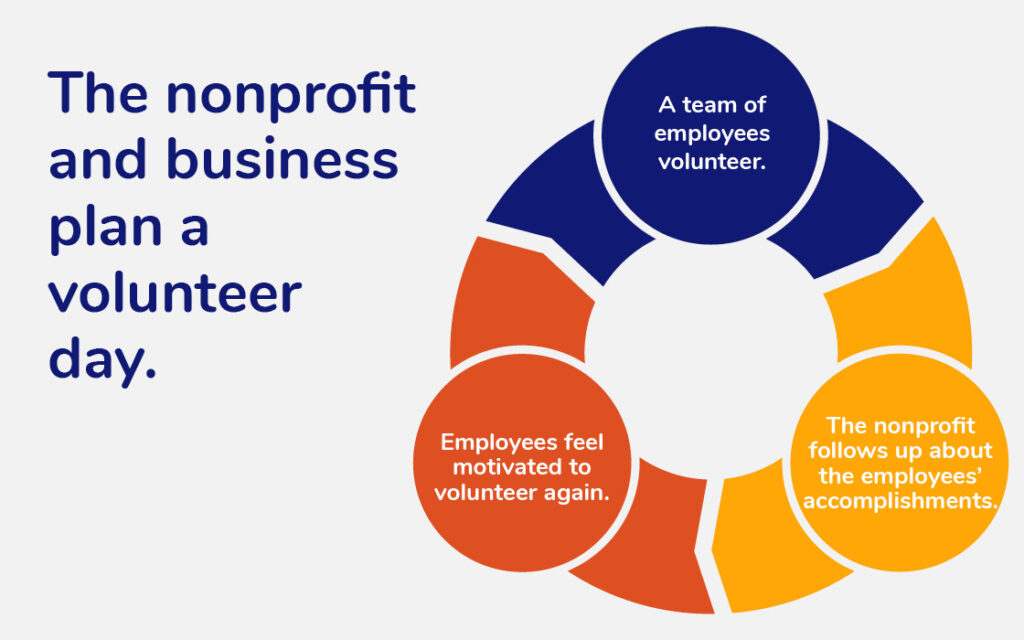
- The nonprofit and business leadership work together to plan a volunteer day. If your nonprofit has a relationship with a business, such as an organization that has sponsored you in the past or you have numerous donors work for, reach out to their leadership to plan a volunteer day. This volunteer day can be on a day the business is normally closed, such as a weekend, or, if the business is open to it, arrange for their team to volunteer on a specific day rather than going into work.
- A team of employees volunteer together. On your specified day, a team of corporate volunteers will arrive to help your nonprofit. Plan activities they can work on as a team. This will help them feel comfortable as they’ll be working with people they know, which can strengthen office relationships by giving them a new environment to work together in.
- The nonprofit follows up on the corporate volunteer team’s accomplishments. This last step can determine whether your volunteer day is a one-time event or becomes a recurring program. Share data with the volunteers and their employer about what they accomplished and how their efforts helped your mission. Even if the employer chooses not to organize a future volunteer day, individual employees who enjoyed the experience might be inspired to come back again.
If corporate volunteers aren’t possible for your nonprofit, you can still leverage workplace giving programs via corporate volunteer grants. Volunteer grants are donations businesses make to the nonprofits where their employees volunteer. In most cases, these donations will be a set amount for each hour an employee volunteers.
Both volunteer days and volunteer grants are easier to manage with a CSR platform. Volunteer grants especially benefit from a workplace giving solution that allows employees to fill out grant applications and report their volunteer hours.
Final thoughts & additional workplace giving resources
Workplace giving represents an untapped potential for many fundraising teams, offering a path to increased donations, enhanced supporter engagement, and stronger partnerships with corporations. By implementing these expert strategies, organizations can effectively integrate workplace giving into their broader efforts—and boost their overall impact.
As workplace giving programs continue to evolve, embracing our recommended strategies will be crucial for any fundraising team looking to stay ahead and thrive in an increasingly competitive landscape.
Whether it’s optimizing matching gift outreach, promoting payroll deductions, or creating meaningful employee engagement opportunities, these approaches can help nonprofits grow and sustain their missions.
Interested in learning more about workplace giving strategies for fundraising success? Check out these recommended resources:
- Why Workplace Giving Matters for Nonprofits + Companies. Understanding the benefits of workplace giving programs will allow your team to target the programs more effectively. Find out why it matters here!
- 10 Types of Workplace Giving Programs Nonprofits Should Know. Workplace giving programs can come in all shapes and sizes. Explore ten of the most popular forms of workplace giving you can benefit from in this guide.
- Marketing Workplace Giving: 9 Smart Ways to Spread the Word. Ready to increase awareness of workplace giving opportunities? Check out this complete guide to learn more about marketing workplace giving.



